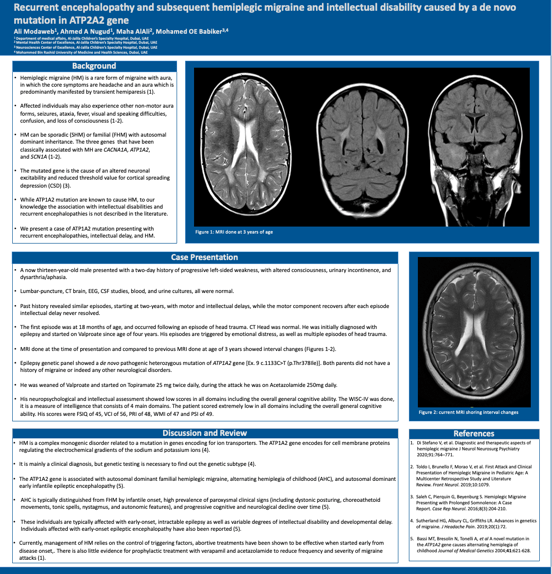Early recurrent encephalopathy and subsequent hemiplegic migraine and intellectual disability caused by a de novo mutation in ATP2A2 gene
Ali Modaweb, Ahmed Abd Alwahab Nugud, Maha AlAli, Mohamed OE Babiker
Objectives: Unlike other migraines with aura, Hemiplegic Migraine (HM) presents with motor aura and deficits. Multiple genes associated with HM including ATP1A2. Herein we present a case of ATP1A2 mutation presenting with recurrent encephalopathies, intellectual delay, and HM. Case presentation: A thirteen-year-old male presented two-day history of progressive left-sided weakness, with altered consciousness, urinary incontinence, and dysarthria/aphasia. Lumbar-puncture, CT brain, EEG, CSF studies, blood, and urine cultures, all were normal. Past history revealed similar episodes, starting at two-years, with motor and intellectual delays, while the motor component recovers after each episode intellectual delay never resolved. He was diagnosed with epilepsy and started on Valproate since age of four years. His episodes can be triggered by emotional distress. MRI done at the time of presentation and compared to previous MRI done at age of 4 years showed interval changes, figure 1. Epilepsy genetic panel showed a de novo pathogenic heterozygous mutation of ATP1A2 gene [Ex. 9 c.1133C>T (p.Thr378Ile)]. He was weaned of Valproate and started on Topiramate 25 mg twice daily, during the attack he was on Acetazolamide 250mg daily. His neuropsychological and intellectual assessment showed low scores in all domains including the overall general cognitive ability.
Case discussion: ATP1A2 gene is associated with autosomal dominant familial hemiplegic migraine, alternating hemiplegia of childhood, and autosomal dominant early infantile epileptic encephalopathy. Conclusion: While ATP1A2 mutation are known to cause HM, to our knowledge the association with intellectual disabilities and recurrent encephalopathies is not described in the literature.
Keywords: ATP2A2 gene, Encephalopathy, Hemiplegic Migraine, Intellectual Disability
Ali Modaweb
Aljalila Children's Specialty Hospital
United Arab Emirates
Ahmed Abd Alwahab Nugud
Aljalila Children's Specialty Hospital
United Arab Emirates
Maha AlAli
Aljalila Children's Specialty Hospital
United Arab Emirates
Mohamed OE Babiker
Aljalila Children's Specialty Hospital
United Arab Emirates
Objectives: Unlike other migraines with aura, Hemiplegic Migraine (HM) presents with motor aura and deficits. Multiple genes associated with HM including ATP1A2. Herein we present a case of ATP1A2 mutation presenting with recurrent encephalopathies, intellectual delay, and HM. Case presentation: A thirteen-year-old male presented two-day history of progressive left-sided weakness, with altered consciousness, urinary incontinence, and dysarthria/aphasia. Lumbar-puncture, CT brain, EEG, CSF studies, blood, and urine cultures, all were normal. Past history revealed similar episodes, starting at two-years, with motor and intellectual delays, while the motor component recovers after each episode intellectual delay never resolved. He was diagnosed with epilepsy and started on Valproate since age of four years. His episodes can be triggered by emotional distress. MRI done at the time of presentation and compared to previous MRI done at age of 4 years showed interval changes, figure 1. Epilepsy genetic panel showed a de novo pathogenic heterozygous mutation of ATP1A2 gene [Ex. 9 c.1133C>T (p.Thr378Ile)]. He was weaned of Valproate and started on Topiramate 25 mg twice daily, during the attack he was on Acetazolamide 250mg daily. His neuropsychological and intellectual assessment showed low scores in all domains including the overall general cognitive ability.
Case discussion: ATP1A2 gene is associated with autosomal dominant familial hemiplegic migraine, alternating hemiplegia of childhood, and autosomal dominant early infantile epileptic encephalopathy. Conclusion: While ATP1A2 mutation are known to cause HM, to our knowledge the association with intellectual disabilities and recurrent encephalopathies is not described in the literature.
Keywords: ATP2A2 gene, Encephalopathy, Hemiplegic Migraine, Intellectual Disability
Ali Modaweb
Aljalila Children's Specialty Hospital
United Arab Emirates
Ahmed Abd Alwahab Nugud
Aljalila Children's Specialty Hospital
United Arab Emirates
Maha AlAli
Aljalila Children's Specialty Hospital
United Arab Emirates
Mohamed OE Babiker
Aljalila Children's Specialty Hospital
United Arab Emirates

Ali Modaweb
Aljalila Children's Specialty Hospital United Arab Emirates
Aljalila Children's Specialty Hospital United Arab Emirates